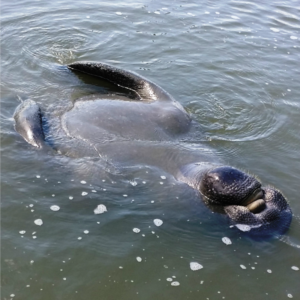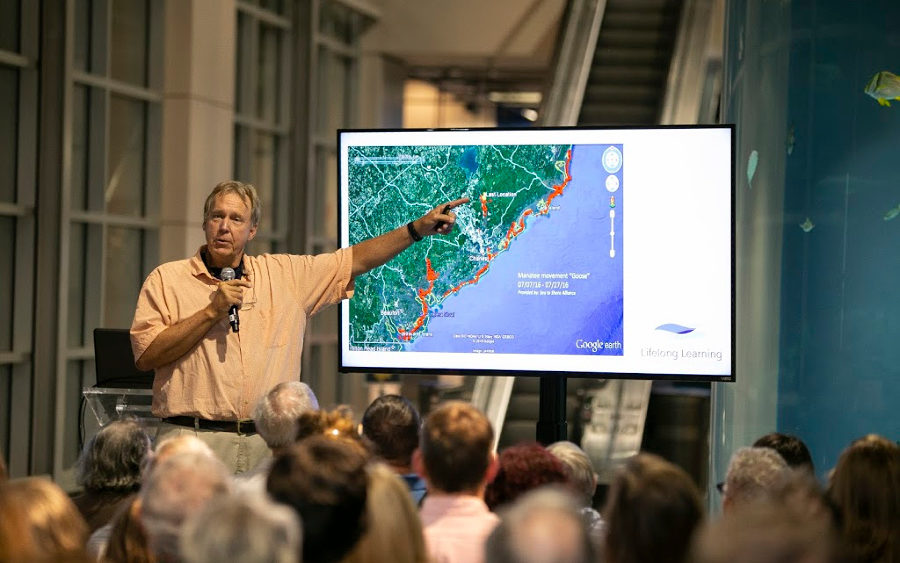Over 150 guests attended the third Holland Lifelong Learning lecture of the season held in the South Carolina Aquarium’s Great Hall. With a slice of Papa John’s Pizza in one hand and a sample of Pawley’s Island Brewing IPA in the other, guests found their seats, anxious to learn from Dr. Al Segars.
Segars recently retired after a long career as the South Carolina Department of Natural Resources (SCDNR) veterinarian and ACE Basin stewardship coordinator. His work has focused on everything from sea turtle health to shorebird nesting to diseases in aquatic animals. As a veterinarian for SCDNR, he also managed the Marine Mammal Stranding Network.
Segars opened with the question: “Do manatees live in South Carolina?” Despite weighing between 800-1200 pounds, they are rarely seen in the Lowcountry. Observation and tagging studies estimate that out of the 6,000 individuals that live in Florida, 50 travel to the South Carolina coast annually, during the summer months.
Manatees are large marine mammals that share much in common with frequently sighted bottlenose dolphins. As mammals, they have hair, they’re warm-blooded, they give live birth and have lungs to breathe. Unlike dolphins, manatees do not have a thick blubber layer. Without this insulation, they need to move to warmer waters when temperatures dip below 68 degrees F.
In recent years, manatees have extended their summer stay in the Cooper River area, finding refuge in the warm water outflows of the paper mill and power plant. Manatees stay in the area as waters cool around them and miss the window to migrate south for the winter.
In 2016, a rescue team from SeaWorld transported 4 manatees back to Florida. One large male, named Goose, was given a satellite tag to better understand his travel patterns. The Sea to Shore Alliance adheres satellite tags with a buoy and antennae that extend above the water’s surface. In 2017, Goose returned to the same location…and wasn’t alone! 10 manatees were transported back to Florida with the cooperation of the local power plant and paper mill and the help of multiple organizations, including SeaWorld, Fish and Wildlife Services, National Oceanic and Atmospheric Administration and SCDNR. These missions couldn’t be completed without SeaWorld’s team and resources.
“It’s almost like Goose said, ‘stick around and they’ll give you a ride back,’” laughed Segars.

Manatees were delisted from Endangered to Threatened, under the Endangered Species Act in 2016. Despite this improvement in habitat and population number, manatees still face many preventable threats. Locally, harassment is a major issue. Under the Marine Mammal Protection Act, harassment includes touching, getting too close, taking a selfie with or “watering” a manatee. Watering is the practice of providing manatees with freshwater from a hose or boat. Manatees are equipped to get their freshwater in different ways, like skimming rainwater from the ocean surface, and do not need human assistance. This practice lures manatees into areas with heavy boat traffic. How much of an issue is boat traffic for manatees? Researchers use boat propeller wounds and scars to tell individuals apart – that’s a pretty big issue!
What can you do? Appreciate manatees from a distance, record your sightings on the SCDNR website, call the SCDNR enforcement hotline at (800) 922-5431 to report harassment and continue to share what you’ve learned; education is the key to manatee survival.
“I’d like my granddaughter to be able to see manatees one day,” smiled Segars.
Join us for the next Holland Lifelong Learning lecture in the new year! Thank you to our sponsors Mary and Mason Holland, Christopher Kauker of Ameriprise Financial, Papa John’s Pizza, Pawley’s Island Brewing and SCDNR.



